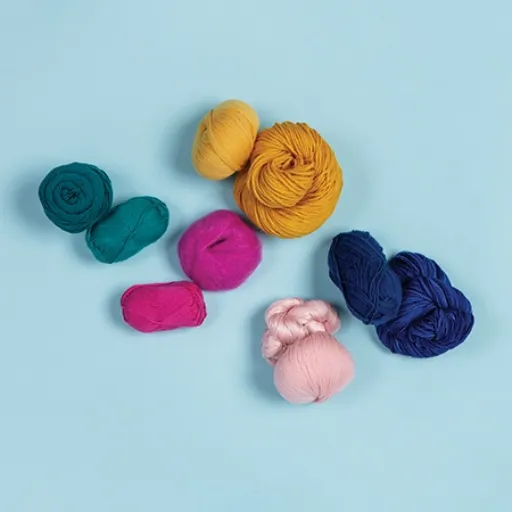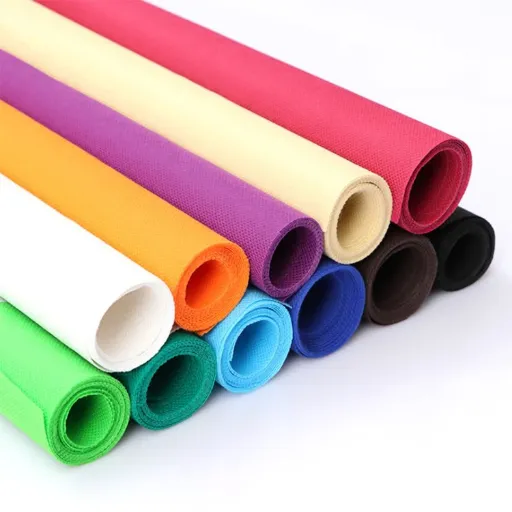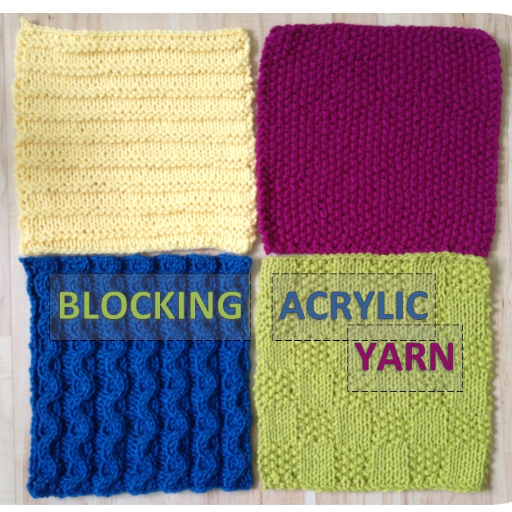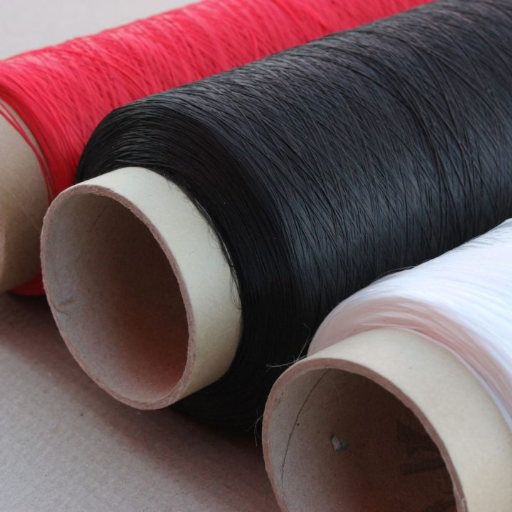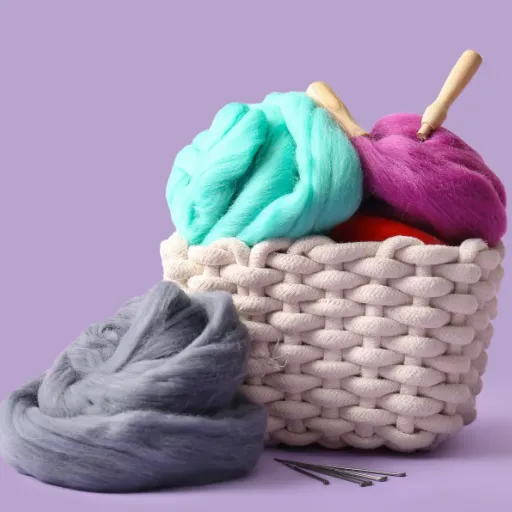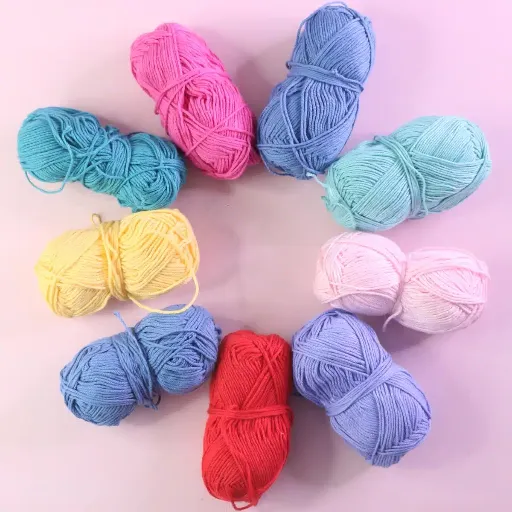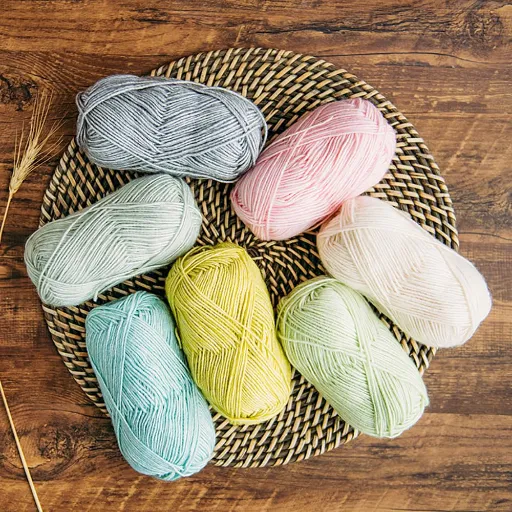Acrylic yarn has gained wide acceptance among crocheting and knitting enthusiasts due to its cheapness, multipurpose use, and the wide range of colors available. It doesn’t matter if you are making warm and comfy scarves for winter, beautiful home decorations, or trying out different patterns, with acrylic yarn, the sky is the limit as far as creativity is concerned. But what makes this synthetic fiber so attractive and how does it compare to the natural ones? This guide will cover all aspects of acrylic yarn, from its source and advantages to working tips and maintenance for your finished pieces. You will be introduced to the world of acrylic yarn whether you are a veteran crocheter or a novice with curiosity. This article is your roadmap to mastering the art and uncovering the reasons why it is the most used material in the crafting community. So, get your projects transformed with this up-to-the-minute material!
What is Acrylic Yarn Made From?
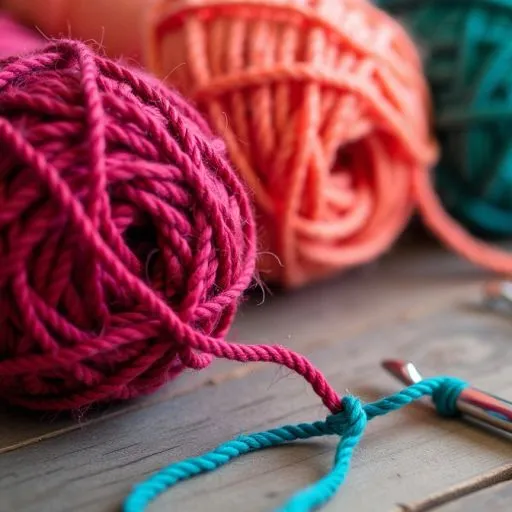
Chemical Composition of Acrylic Fiber
Acrylic fiber is a synthetic fiber with polyacrylonitrile as its main component or constituent. Polyacrylonitrile was made from acrylonitrile, a chemical that is sometimes produced through the chemical processes of manufacturing from petroleum. Acrylic fiber consists of polyacrylonitrile as its major constituent giving the fiber lightness, softness, and durability.
The process of manufacturing involves spinning the polymer solution into filaments, followed by washing, stretching, and treating to obtain the required texture and strength. Such fibers are made to feel like wool but are still cheaper and more adaptable. Moreover, acrylic yarn is sometimes mixed with natural or other synthetic fibers to boost its functional features and aesthetic appeal for various crafting applications.
The amazing property of acrylic fiber is the dye-sinking capacity, which allows for beautiful and durable projects to be made with the material. Its non-shrinking and mildew-and-pest-resistant nature are another reason for its being so popular among hobbyists. The combination of these features, alongside its being affordable, makes acrylic the favorite or even the only choice of yarn for novice as well as skilled crocheters and knitters.
Manufacturing Process of Acrylic Yarn
Acrylic yarn is made from acrylic fiber and which is a synthetic fiber made from oil and chemical condensation. Materials used in the manufacturing process of acrylic yarn are primarily acrylonitrile polymer, which is the main raw material. The long-chain polymers are created through the polymerization of acrylonitrile, which is a very durable and versatile material. The polymer produced is then melted and mixed with a solution to make it ready for processing.
The next step is to spin the diluted polymer into fibers using either the wet-spinning or dry-spinning technique. In wet spinning, the solution is pushed through a nozzle into a container filled with a liquid that makes the polymer turn into fibers. In dry spinning, a room with warm air is used to evaporate the solvent and keep the solid fibers. Stretching the fibers after they are created is necessary to get strong and even fibers, which is very important for the production of yarn.
After the fibers are ready, they go through different finishing processes, among them crimping to create a soft texture, cutting to required lengths, and dyeing to get bright colors. The fiber finally becomes acrylic yarn through the spinning process. Acrylic yarn, because of its synthetic nature, is produced in large volumes at low cost and is thus a favorite among manufacturers and consumers. The whole process guarantees that the yarn will possess the main properties of durability, resilience, and softness, thus being suitable for many applications.
Comparison with Natural Fibers
Acrylic yarn, when compared to natural fibers such as wool, cotton, or silk, brings up several differences that assist in determining their uses and the preferences of consumers. Acrylic yarn, for instance, imitates the softness and warmth of wool, but its price is much lower and maintenance is also much easier. Besides, acrylic yarn is less attractive to insects like moths and thus does not go through shrinking or felting during washing cycles, which makes it a suitable choice for many families.
Breathability and absorption of moisture are the main advantages of natural fibers. For instance, wool is famous for its temperature-regulating quality and is able to keep the user warm in winter and cool in summer. Cotton, being hypoallergenic and having the ability to absorb moisture, is thus suitable for daily use. Silk, on the other hand, is known for its elegant feel and natural glossiness.
Looking at the environmental side of things, natural fibers are compostable and their source is renewable thus they have a little ecological footprint over time. On the contrary, they often consume more water, land, and energy for production and processing. Acrylic yarn has the same argument as a synthetic fiber; it is petrochemical-based, which calls for concern regarding its non-biodegradable nature. However, advancements in recycling technologies are consistently making the sustainability of synthetic fibers better.
Properties of Acrylic Yarn
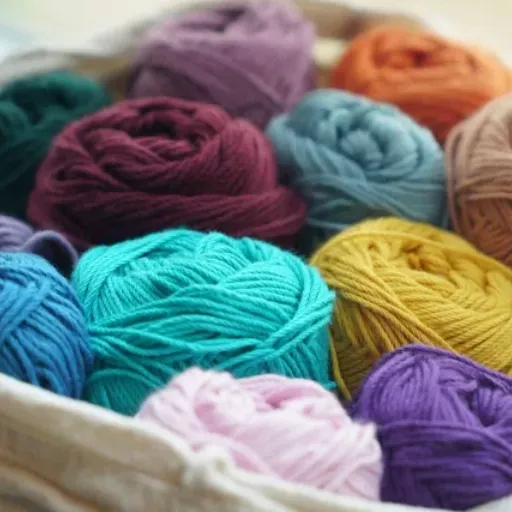
Durability and Strength
Acrylic yarn is commonly known for its toughness and strength, which is why it has become the preferred choice in the textile industry. Together with the synthetic nature of the material, it is durable enough to be used for long periods of time in a variety of applications without becoming brittle or breaking. The high durability of acrylic yarn, for example, is one reason for its widespread use in high-end textiles, as the fabric withstands for years without losing its quality.
Moreover, its long life can be attributed to its limited exposure to the elements since its yarn is completely sealed off from the elements that can damage the natural fibers. Some natural fibers, on the other hand, would succumb to damage caused by sunlight or moisture. Therefore, acrylic yarn is fit for outdoor items and temporary products such as blankets and jackets. In addition to this, it has one significant advantage of not only retaining its structural integrity but also its visual appeal since it doesn’t fade easily even after many washes.
Although acrylic yarn is strong and long-lasting, it is still a synthetic material so it does not let nature take its course through biodegradation. This has led to negative perceptions of its impact on the environment. Nonetheless, technology has been developing with the help of recycling companies where they take back used acrylic materials thus reducing plastic waste considerably. So it wouldn’t be an exaggeration to say that strength, resistance, and versatility combined robustly together are a perfect claim for getting the best of all.
Colorfastness and Dyeing Techniques
Colorfastness is the degree to which a material preserves its color under the influence of external factors, such as light or water, or through repeated washing it many times. The control of colorfastness in a material is one of the factors contributing to its longevity and aesthetic appeal. The properties of the dye, the method of dyeing, and the kind of fabric dyed are the main parameters that affect colorfastness. On the other hand, poor colorfastness can lead to fading, bleeding or discoloration of the material, thus making its use restricted.
The latest dyeing methods are focused on maximising the dye fusion with the fiber to get the most durable and impactful colors. Among these methods are direct dyeing, reactive dyeing, and solution dyeing, the final choice between them is made considering the fiber type as well as the required outcome. For instance, reactive dyes are used extensively in the dyeing of cellulosic fabrics because of the formation of a strong chemical bond with the substrate that allows for better color retention even after multiple phases of washing. On the other hand, pretreatment processes such as enzymatic or chemical ones can be employed which will help in enhancing the dye uptake by the substrate.
The use of more advanced methods in dyeing has made a positive impact in the area of sustainability. The reasons for it include less consumption of water and energy, as well as the application of non-polluting dyes. Hence manufacturers can lessen the ecological footprints resulting from dyeing processes. Among the new methods, digital printing and waterless dyeing are gaining popularity as they provide high-quality products with minimal waste production. The practice of innovation in this field thus reflects the dynamic interplay of the factors of performance and environmental responsibility.
Texture and Feel
The feel and texture of textiles are major factors in assessing their quality, comfort, and usability. Texture denotes the surface features of the fabric and the way it appears and feels under touch. These features may be as smooth and soft as silk or as rough and coarse as burlap. Rather, the feel is more related to the material’s skin touch, which has a direct effect on the wearer’s experience.
There are several factors that affect the texture and feel of a textile, such as the kind of fiber used, the weaving or knitting process, and the finishing treatments applied. Natural fibers like cotton and silk are usually very soft and luxurious; hence, their commonly used in textile production. The same characteristics can be developed or even completely synthetic fibers can be created to imitate the natural fibers or even subtly superior ones. The smoothness of tight-weave fabrics is usually greater than that of those made with loose weaves that allow more air but a rougher feel.
The importance of texture and feel is not only in the aesthetics and sensory appeal. It is also a function of the material. For instance, fabrics made for sportswear will always have softer textures to help with reducing friction while coarser textures will be used for outdoor materials to ensure that the fabric is hardy enough to resist wear and tear. The whole process of getting the desired texture and feel is a delicate balancing act of material selection and manufacturing techniques whereby both performance and comfort are assured in the final product.
Pros and Cons of Using Acrylic Yarn
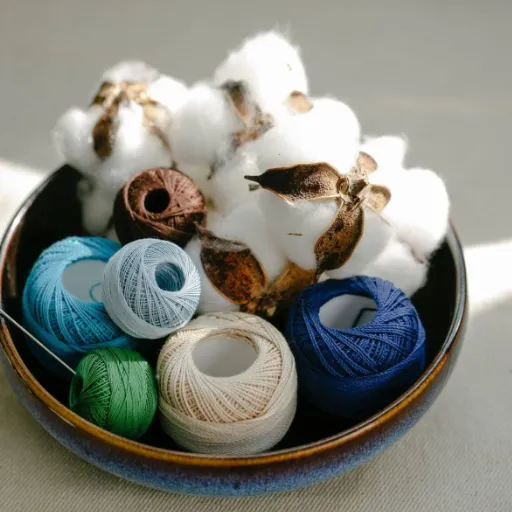
✓ Advantages of Acrylic Yarn
Acrylic yarn comes with a great number of benefits thus making different textile-related fields its application. Luckily for both retailers and consumers, its characteristics led to widespread popularity. The following are the most significant ones:
- Affordability
When compared to natural fibers such as wool and cotton, acrylic yarn is much cheaper. Because of this, the yarn becomes affordable for both massive projects and daily art/craft activities, therefore users can make long-lasting products without going over budget.
- Durability and Strength
Among its many other properties, acrylic yarn is recognized as durable. The claims concerning its performance are not without basis; it indeed withstands the elements similar to plastic and some natural fibers. Several types of research have been done on these fabrics and their properties show they can last for a long time regardless of repeated washing and physical stress.
- Lightweight and Warm
Acrylic yarn is a very lightweight material that has very good insulation properties thus making it suitable for winter clothing and blankets. It is a close imitator of wool in terms of its ability to provide warmth, but at the same time, it is much easier to manage and take care of.
- Color Versatility
Acrylic fibers have the capability of being dyed in a great variety of colors, resulting in very vivid and durable tints. The dyeing procedure has a tendency to be simpler than that of the natural fibers, and thus the color has a better chance of not being easily washed away passing the time.
- Moisture-Resistant and Easy Care
Inherently, acrylic yarn has the property of moisture-wicking which is the reason why its water uptake is not largely observed during washing. The fiber dries quickly, rarely shrinks and is machine-washable making it a low-maintenance option not only for clothes but also for household items made/textiles.
- Allergy-Friendly
Being a synthetic product, acrylic yarn contains no proteins which are the culprits of allergic reactions in the case of animal fibers like wool. Hence it is a natural choice for people with sensitive skin or allergic to wool.
- Wide Range of Applications
One of the biggest boons of acrylic yarn is its adaptability to various applications making it the most sought-after material whether for knitting or crocheting or even to use in industrial textiles and upholstery. The fiber’s ability to replicate the advantages of natural fibers but at a lower cost is unrivaled.
Market Insight: In line with the latest market analysis, it has been forecasted that the global acrylic fiber market will enjoy a gradual increase in its growth such that by 2028, the market will be worth about USD 4.2 billion due to the textile industry’s increasing demand and the continuous advancements in the processes of manufacturing. This, in turn, gives more credence to the fact that acrylic yarn will continue being a very important fiber in today’s textiles.
✗ Disadvantages of Acrylic Yarn
Acrylic yarn is in many instances quite popular and common to use in the textile industry, but, at the same time, it possesses some disadvantages worth paying attention to:
- Non-Biodegradable Nature
Acrylic yarn consists of synthetic fiber manufactured from polyacrylonitrile, which is a kind of plastic sourced from petroleum. Thus, it is non-biodegradable, thereby contributing to environmental pollution. Recent data shows that about 60% of the global textile waste comprises synthetic fibers, including acrylic, and a significant portion of this waste is either dumped in landfills or oceans.
- Environmental Concerns in Production
The production of acrylic yarn involves the use of toxic substances like acrylonitrile, a chemical that can cause serious health problems for the workers handling it and can also harm the environment if not disposed of properly. There are claims that the factories producing acrylic can discharge harmful emissions which would further lead to the contamination of air and water. This has already raised the issue of its environmental sustainability.
- Lack of Breathability
Acrylic underperform when underperforms compared which natural fibers such as cotton or wool in terms of breathability. It has the potential to trap not only the heat but also moisture which is why the fabric made from it is not wearable in warm or humid environments. Research indicates that the use of synthetic fibers like acrylic makes the wearer uncomfortable in the long run because of their inability to wick moisture away properly.
- Flammability
Acrylic fibers are very compared, and once they catch fire, they not only burn quickly but also melt at the same time, thereby causing serious skin burns. Some products made from acrylic are however treated with flame retardants, yet such use of chemicals raises the issue of the environment and human health.
- Lower Durability Over Time
Although at first, acrylic shows quite good durability, eventually it will lose its spirit. UV light constantly reduces both the color and strength of the fabric, thus making it less suited for outdoor applications. Besides, the fabric is prone to forming pills, which might eventually lead to the deterioration of the visual appeal and quality of the finished clothing.
- Microplastic Pollution
The synthetic nature of acrylic yarn is a major factor in the global microplastic pollution problem. During laundry, small acrylic fibers are released and they find their way to the waterways. A recent study showed that the washing of synthetic fabrics is responsible for about 35% of primary microplastic pollution released into the environment. These microplastics can eventually contaminate marine life and even end up in the human food chain, thereby posing a health risk.
Important Note: These drawbacks suggest that industries and consumers should work to adapt more sustainable practices, such as recycling acrylic fibers and investing in eco-friendly alternatives.
Environmental Impact Considerations
The repercussions on the environment caused by the synthetic fabrics is so huge that it is high time to deal with this issue. The washing of these materials causes the release of microplastics into the water systems, and these tiny particles in the water represent a large part of the worldwide microplastic pollution. The microplastics are not going anywhere as they are non-biodegradable and they keep piling up in the water bodies where they affect the fish and other marine creatures, as well as the overall biodiversity of that area.
In order to solve these problems, both industries and consumers have to engage in sustainable measures. Manufacturers will put their effort into making products from biodegradable and recycled materials, thereby reducing the use of synthetic fibers to a minimum. Moreover, the installation of advanced sewage treatment facilities can play a significant role in trapping the microplastics before they contaminate the rivers and lakes. In terms of the customer, using less washing for synthetic garments or the use of machine filters could be the solution to the microplastic shedding problem.
The interaction among the lawmakers, the industries, and the public is highly necessary if the long-term solutions are to be realized. One way the government can do this is by altering the legal framework concerning microplastic release and supporting research into substitutes. Increasing the population’s awareness of the negative environmental impacts of synthetic fabrics can be a very powerful tool for promoting and making environmentally friendly purchase and use decisions. It is through these combined activities that the environmental impact of synthetic fabrics can be drastically lessened.
Common Uses of Acrylic Yarn
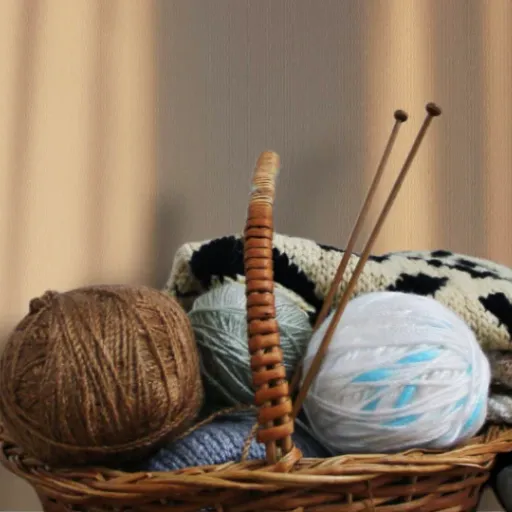
Applications in Fashion
The fashion industry is one of those that extensively use acrylic yarn for it is an economical, flexible, and long-lasting material. It is frequently applied in the production of various pieces of clothing, including cardigans, wraps, headwear, and stockings. Thanks to the gentle touch and natural fiber-similar feel of acrylic yarn, especially in the case of wool, the garments made from it are not only comfortable but also loved by consumers who want to save but still have good quality.
The next application of acrylic yarn is to produce fashion accessories and bold items. In the case of thick knitted purses and embellished shawls, the use of acrylic yarn’s bright tones and its non-fading quality made the items very attractive and durable for the long run. Moreover, its lightweight property gives the opportunity to create warm weather and cold weather wearables that are comfortable to use without the concern of getting them ruined during washing or shrinking.
To the point of the matter, it is another aspect where acrylic yarn is utilized in fast fashion and mass production. Since its price for production is minimal and it can easily be made, it helps with the large-scale production of clothing that is not only trendy but also affordable. Yet, it is crucial to mention that its environmental impact is a concern, as synthetic fabrics like acrylic become a source of microplastic pollution, thereby stressing the need for the fashion industry to be more considerate in its production and usage.
Home Decor Projects
Acrylic yarn is an amazing material for many home decor projects owing to its versatility, affordability, and easy access. It is usually applied for crocheting or knitting things such as throw blankets, cushion covers, and rugs. The bold and bright shades along with the toughness of the material, make these products easily visible and, besides, the comfortable and individualized character that any room gets, will be a part of the space. In contrast to some of the natural fibers that require extra care, acrylic yarn is very user-friendly as it does not lose its color and can be machine-washed in many cases.
Another area where acrylic yarn is used most in home decor is making wall hangings or macrame designs. The acrylic yarn with its smooth texture and different thicknesses available provides an opportunity to create patterns that are not only intricate but also alive with colors and at the same time, such patterns can go with the interior styles from bohemian to modern. Besides, the yarn can also be used for making small decorative pieces like tassels and pom-poms which can be added to the lampshades or curtains to give a playful charm.
On the other hand, as much as acrylic yarn is versatile its environmental impact is something to be concerned about since it is of a synthetic nature. Making thoughtful and decorative pieces that can be reused will help in reducing the impact and thus the projects will last for a long time. For those who are focusing on creating sustainable home decor, the option of combining acrylic with natural fibers or concentrating on upcycled materials will serve the purpose of having a design that is both functional and eco-friendly.
Crafting and DIY Ideas
Acrylic yarn is a type of synthetic fiber that is made from the polymerization of acrylonitrile, which is a petrochemical obtained from either oil or natural gas. The production process includes the chemical processing of acrylonitrile monomers to develop long chains resulting in a fiber that is both light and strong. This fiber is then drawn into yarn which is known for its use in various forms of art like crafting, knitting, and crocheting, among others.
The main factor behind the popularity of acrylic yarn is its economic cost and versatility. It looks and feels like natural fibers such as wool but often the care of this synthetic fiber is easier, because it is laundry-safe, non-shrinking, etc. Besides, the availability of acrylic yarn in a multitude of colors and weights makes it a perfect choice for different types of projects ranging from warm and snuggly blankets to colorful and stylish scarves.
On the downside of things, being an oil product, acrylic yarn cannot be composted and might contribute to the pollution of the planet. Recycled acrylic or blends that have a portion of natural fibers may be the options for environmentally conscious consumers. The knowledge of acrylic yarn’s composition can help the artists to pick up the right materials and at the same time to be aware of their environmental impact.
Acrylic vs Natural Yarn

Cost Comparison
Among the different types of yarn, acrylic is usually less expensive than natural yarns like wool, cotton, or alpaca. The reason for this is that acrylic is manufactured in huge quantities using synthetic fibers which leads to lower production costs and a steady supply. It is therefore the most economical choice for those who are working on projects that require less than a hefty investment.
In contrast, natural yarns are usually quite pricy due to their sourcing and processing. Wool, for example, is the product of the shearing, cleaning, and processing of animal fleece, while cotton is produced through farming and harvesting. All these labor-intensive techniques and the employment of top-quality materials lead to high prices. Moreover, natural yarns are often regarded as luxury items, particularly when they are sustainably sourced or handcrafted.
The decision for hobbyists and artisans often relies on project specifications and personal finances. Acrylic yarn would be suitable for the production of everyday items or for teaching beginners to be more proficient in the craft, whereas natural yarns would be the first choice for making elegant, long-lasting, and eco-friendly pieces. Whatever your priorities are, be it cost or going green, they can certainly assist you in reaching your conclusion.
Performance in Knitting and Crochet
Acrylic yarn and natural yarn, the two types, yield different results in knitting as well as crochet, each attracting certain users and their likes. Acrylic yarn is very light, long-lasting, and not difficult to work with, qualities which make it the one for a beginner or someone making a large item, such as a blanket, or a small one, like a scarf, or a decorative item. It has a very smooth surface and therefore it passes easily through the crochet hooks and knitting needles which eventually leads to the sooner completion of the projects.
Conversely, natural yarns, e.g. wool, cotton or alpaca, always give the best definition of the stitch and the softest finish. Being air-permeable and at the same time regulating the temperature makes them most suitable for the making of garments that not only look good but also last long. Nevertheless, natural fibers are more demanding in terms of care during use and maintenance since they are prone to shrinkage or felting if not treated properly.
In the end, it is the project that dictates the type of yarn to be used the most. Acrylic yarn is perfect for practice and creative work with a wide range of applications while natural yarns are for the most delicate or heirloom-quality pieces. The decision for the right yarn is a matter of weighing these factors against each other to get the best working conditions for your specific project.
Longevity and Care
The longevity of a yarn-based project is contingent upon the yarn type, its quality, and the care given throughout its life. Among natural fibers, wool, cotton, and silk offer good durability but also need gentler treatment to keep their quality. On the other hand, acrylic and other synthetic yarns have a longer life and are less affected by the environmental factors such as moisture or heat, which makes them the right choice for projects that require durability due to frequent use.
The quality and look of yarn-based works are largely dependent on their care. Washing instructions must always be strictly followed, as many natural fibers will accept only handwashing or very gentle cycle with cold water. This is the opposite with synthetic yarns which usually can be machine-washed and are less likely to shrink or stretch. One more way to keep yarn prevent fading and distortion is to store it in a dry cool place away from direct sunlight.
It is very important to inspect the project regularly for wear or damage to ensure its longevity. Quick repair of loose threads or fraying edges can prevent further unraveling. Besides, using protective storage methods like breathable fabric bags or sealed containers can effectively keep dust, pests, and moisture away. So, the right yarn selection together with consistent care practices will make a yarn-based project last for years.
Frequently Asked Questions (FAQ)
Q: What is acrylic yarn made from?
The material used to make acrylic yarn is synthetic fibers of which the main and predominant one is the polymer from the plastic family, that is, polyacrylonitrile. The production starts with the process of polymerization, which is the joining of the chemical compound called acrylonitrile. Hence, we have the synthetic yarn that imitates the natural fibers such as wool or cotton.
Q: How does acrylic yarn compare to natural fibers like wool or cotton?
The choice of acrylic yarn over other natural fibers such as wool or cotton is often made because of its low price and wide range of use. Wool is known for its warmth and ability to breathe, whereas acrylic yarn gets the advantage of being machine washable and easy to maintain. The crafters also love the vast selection of colors and textures that the acrylic yarns have to offer.
Q: Can acrylic yarn be used for sock yarn projects?
Absolutely, acrylic yarn can be used for sock yarn projects. A large number of crafters prefer to work with a blend of acrylic and nylon, which makes the yarn more durable. Furthermore, acrylic yarn can retain heat and is usually gentler to the skin than conventional sock yarn made with natural fibers.
Q: Is acrylic yarn a good choice for beginners?
Acrylic yarn is the most chosen yarn for beginners because it is good value for money and easy to work with. It is available almost everywhere, comes in different colors, and is usually machine washable, thus being a convenient choice for new crafters.
Q: Are there any alternatives to acrylic yarn?
Yes, there are alternative yarns to the acrylic ones, such as yarns made from natural fibers like cotton and wool. Each one has its strengths, e.g., wool is warm, whereas cotton is soft and cool. The selection of yarn depends upon the project requirements.
Q: What are the benefits of using acrylic yarn?
Acrylic yarn has many advantages, which include a lightweight nature, longer life, and resistance to moths. It is also presented in a wide range of colors and textures, which is why it is a preferred choice for innumerable types of projects. Furthermore, Acrylic yarn is frequently cheaper than yarn made of natural fibers.
Q: How is acrylic yarn produced?
The process of producing acrylic yarn starts with the production of acrylic fibers. Spinning these fibers creates the yarn that can then either be dyed or treated in different ways to produce various textures. So, the production process of yarn types covers a wide variety that can be customized according to crafting needs.
Q: What items can be made with acrylic yarn?
A variety of items can be made with acrylic yarn, such as sweaters, hats, blankets, and other accessories. Its properties such as versatility and easy maintenance turn it into a preferred choice of crafters for both practical and artistic projects.
Q: Where can I find an acrylic yarn that suits my project?
Most probably, you will find acrylic yarn at craft stores, but you can also shop for it on the internet. Many brands have a wide range of colors and textures which will enable you to select the most appropriate yarn for your project. Make sure to look for yarn that has the exact qualities you want, like softness, strength, or hue.
References
- Mary Maxim – Acrylic vs Cotton Yarn – Explains that acrylic yarn is a synthetic fiber made from petroleum-based products.
- Darn Good Yarn – Acrylic Yarn vs Natural Yarn – Describes acrylic yarn as being made from a poly compound called acrylonitrile, derived from fossil fuels.
- Secret Yarnery – How Acrylic Yarn Is Made – Provides a step-by-step guide to the production of acrylic yarn, highlighting its synthetic nature and petroleum-based origins.
- The Spruce Crafts – Definitions and Uses for Acrylic Yarn – Offers an overview of acrylic yarn, its synthetic composition, and its various uses.
- Darn Good Yarn – Environmental Impact of Acrylic Yarn – Discusses the synthetic nature of acrylic yarn and its environmental implications.








